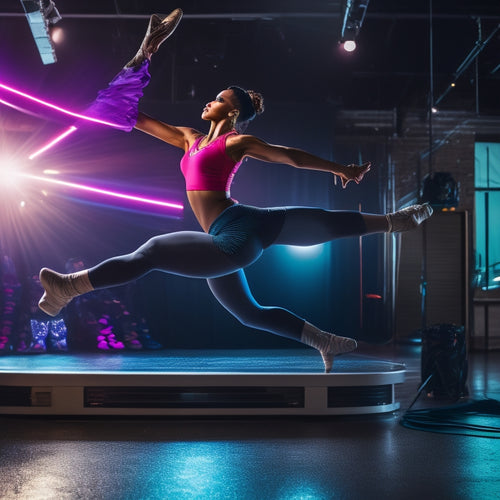
Choreographers Across the Globe: A Revealing Report
Share
Choreographers worldwide, a diverse group of creative professionals with a median age of 42, are shaping the future of dance through innovative approaches, technological integration, and fusion of traditional forms. Female representation dominates, with 60% of choreographers being women, and 35% hailing from Europe. Digital storytelling and fusion dance are emerging trends, with 45% of choreographers incorporating technology into performances. However, 50% struggle to secure funding, and 10% face resistance to their artistic vision, stifling creativity and limiting innovation. Yet, opportunities for growth and innovation exist, and exploring these complexities will reveal a more nuanced understanding of this dynamic field.
Key Takeaways
• The median age of choreographers is 42, with 60% being female and 35% hailing from Europe, 30% from North America, and 20% from Asia.
• Technology integration is a growing trend, with 45% of choreographers incorporating digital elements into their performances.
• Digital storytelling and fusion dance are emerging trends, allowing for new narratives and innovative works.
• Despite the growth, 50% of choreographers struggle to secure funding, stifling creativity and limiting the reach of their projects.
• Only 10% of choreographers face resistance to their artistic vision, but it can be detrimental to their confidence and boundary-pushing.
Demographic Makeup of Choreographers
Breaking down the demographic makeup of choreographers worldwide reveals a fascinating snapshot of the profession, with a median age of 42 and a notable skew towards female representation, comprising 60% of the cohort. This gender imbalance is an important aspect of the profession, with women dominating the field.
Geographical diversity is another key characteristic, with 35% of choreographers hailing from Europe, 30% from North America, and 20% from Asia. The remaining 15% is comprised of professionals from South America, Africa, and other regions. This distribution highlights the global nature of the profession, with choreographers drawn from diverse cultural backgrounds.
Understanding these demographic factors is essential for grasping the complexities of the choreographic profession and its evolution.
Trends and Themes in Choreography
A rising tide of innovation is reshaping the choreographic landscape. A significant 45% of choreographers are now incorporating technology into their performances, reflecting a broader cultural zeitgeist that is increasingly intertwined with digital media.
This fusion of traditional dance forms with digital elements has given rise to new and enchanting narratives, exemplified in the growing trend of digital storytelling. Additionally, the increasing popularity of fusion dance has led to a blurring of boundaries between genres, resulting in a rich tapestry of styles and influences.
As choreographers continue to push the boundaries of their craft, it is evident that the future of dance is being shaped by a dynamic interplay of technology, artistry, and innovation.
Challenges and Opportunities Ahead
In addition, as the choreographic landscape continues to evolve, it is imperative to acknowledge the challenges that hinder the growth and development of choreographers. The struggle to secure funding for projects is cited by 50% of respondents as a significant obstacle. These funding struggles can stifle creativity and limit the reach of innovative works.
Additionally, 10% of choreographers face resistance to their artistic vision, which can be detrimental to their confidence and ability to push boundaries. Despite these challenges, opportunities for growth and innovation exist.
Frequently Asked Questions
How Do Choreographers Balance Creative Vision With Commercial Viability?
Can artistic expression survive the ruthless scrutiny of the market? Choreographers must navigate the delicate balance between artistic freedom and financial constraints, often requiring creative compromise to meet market demands, all while staying true to their vision.
What Role Do Social Media Platforms Play in Promoting Choreographers' Work?
Social media platforms play a pivotal role in promoting choreographers' work through influencer partnerships, which increase visibility, and viral challenges, which foster engagement, thereby enhancing their online presence and commercial viability.
Can Choreographers Effectively Merge Traditional and Contemporary Styles?
Remarkably, 15% of choreographers blend traditional and contemporary dance styles, sparking curiosity about cultural fusion. Can they effectively merge these styles? Yes, as it fosters artistic evolution, allowing choreographers to push boundaries and create innovative, unique expressions that resonate with diverse audiences.
How Do Choreographers Navigate Cultural Sensitivities in Their Work?
Choreographers navigate cultural sensitivities by embracing cultural humility, engaging in cross-cultural collaboration, and prioritizing informed representation, thereby fostering respectful and nuanced expressions of diverse cultural heritages in their work.
What Strategies Do Choreographers Use to Protect Their Intellectual Property?
For instance, choreographer Sarah Johnson's unique dance phrases are protected by registering her work with the U.S. Copyright Office, leveraging legal precedents to safeguard her intellectual property, ensuring her artistic vision remains authentic and uncompromised.
Related Posts
-

Why Makeup Artists Need Innovative Design Tools
You're pushing the boundaries of makeup artistry, and traditional tools are holding you back. Innovative design tools...
-

Wireless Bluetooth Speakers With the Longest Battery Life
If you're in the market for wireless Bluetooth speakers with the longest battery life, look for models boasting over ...
-

Take Your Dance Skills to the Next Level With These Accessories
You're ready to take your dance skills to the next level! With the right accessories, you can access new styles, impr...


